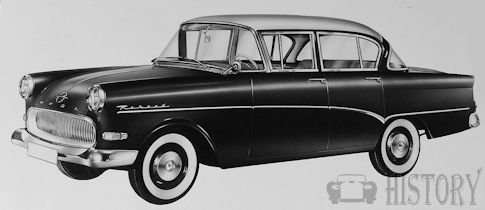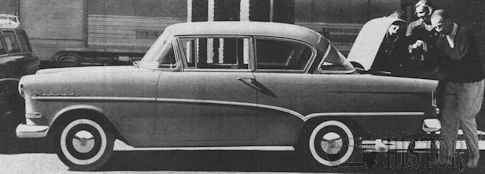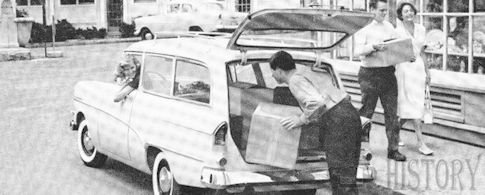Opel Rekord P1
 | |
Make | Opel |
Production period: | 1957 to 1962 |
Class : | Motor car |
Body versions : | Limousine ,van, station wagon |
Engines: | Petrol 1.2-1.7 liters |
The Opel Rekord P1 (originally Opel Olympia Rekord P ) is a car from Opel built from the summer 1957 as a successor to the Opel Olympia Rekord. A striking feature of this model were the panoramic windows after the model of 50s American vehicles.
The P1 record proved to be a great sales success both domestically and in export . Between August 1957 and July 1960 were delivered 509,110 vehicles, of which 394,692 sedans, station wagons and 109,282 15,136 vans. There were also 67,952 units of the Opel 1200 .With newly designed body and largely the same technology came in August 1960, the record P2 on the market. As Opel 1200, the P1 was built until December 1962.
Opel Rekord History
On August 13, 1957, This was successor of the Opel Olympia record . Equipped with a fashionable body, the new car immediately found great popularity. Paintings and fabric interiors were available in two colors.The newly designed double wishbone - front axle with negative camber and different length wishbones and the new fully synchronized three-speed gearbox with steering wheel circuit and the 45-hp engine with 1.5 liter displacement (the predecessor Olympic record 40 hp) gave a new driving experience.
The vehicle was initially offered only two-door. At the turn of 1958 there were some changes to the equipment. The made of metal sun visor holder and also made of metal round clothes hooks in the rear were made from 1958 made of plastic. The design of the sun visors changed, there were other minor changes to the rear taillights. The aluminum trim below the windscreen was pulled further towards the doors. From the beginning there was also a station wagon and a "delivery van ". The Americans said, "It's a car and a van,"both a car and a van. The CarAVan was bought mainly by craftsmen, because he offered the optimal combination of private and company cars with a correspondingly high payload. That was also the reason why only a few of these station wagons have survived until today. Generally it was frowned upon to drive a "craftsman car" privately as well. After the plant holidays in 1959 Opel offered the record P as a four-door sedan , while the station wagon variants always remained two-door. The previously massive trunk lid handle made of cast iron was replaced by a variant made of light metal.
There was also a two-door base Olympia (also known as Olympia P1 ). This model had no side moldings, many of the other versions of chrome-plated parts were painted, and the interior was kept simpler. So the chrome ring on the steering wheel and the Kienzle clock with 8-day lift mechanism were missing - whose opening in the instrument insert was covered with a black plastic cap. The Olympia P1 wore on the front fenders not the words "record" as Caravan and delivery van, but "Olympia".
As a new basic version Opel replaced in October 1959 the Olympics by the Opel 1200, which was intended as a competitor to the VW Beetle. The Opel 1200 engine made 40 hp from 1.2 liters. Laterally, a narrow, slightly curved decorative strip was mounted as a distinguishing feature instead of the large swingarm, above the front fenders the lettering "1200" was mounted. Also this model had no writing "record" at the front fenders. The equipment was not quite as Spartan as the Olympics. The longer than the stronger versions, which were replaced in 1960 by the Opel Rekord P2. For export there was a corresponding model as "Opel 1500".
The first changes were made in the spring of 1958: instead of the dashboard, the rear view mirror was fixed to the upper edge of the window and, for the first time in this series, an electric, two-stage windscreen wiper was installed. Until then, the camshaft propelled the windshield wipers via a flexible shaft; a solution that was first used in 1937 in the Opel Super 6 .In the summer of 1959, a revised 1.5-liter engine was introduced, which instead of 45 hp (at the old Olympics record 40 hp) made 50 hp. This performance increase was achieved mainly by changes to the cylinder head and the exhaust manifold . At the same time appeared a 1.7-liter engine with 55 hp, which was marked by a 1700er lettering on the rear panel and how the other engines had no oil filter . Otherwise, based rows - four-cylinder machines with Overhead valves on the pre-war construction of the Olympic motor of the 1937th
From the spring of 1958 there was the Olympic record P1 on request with "Olymat" (in contrast to the conventional Saxomat with double clutch ), an automatic clutch from Fichtel & Sachs , which, however, found only moderate popularity. The system consisted of a centrifugal clutch for starting and a second clutch for changing the gears; There was no clutch pedal. The actuated by the negative pressure of the engine second clutch was activated when switching by an electrical contact on the shift lever. Vehicles with Olymat received an "Olymat" logo under the rear window.
Autenrieth in Darmstadt offered coupé and convertible conversions, which remained a rarity not least because of their high purchase price. A total of 25 convertibles are said to have emerged, of which four are still known today.

Only in Switzerland was the special Opel Rekord Ascona model manufactured by GM Suisse in Biel in small quantities from the end of 1959 onwards . Named for the town of Ascona on Lake Maggiore , the model was equipped with the 1.5-liter engine with 55 hp and a three-stage two-color with always white roof, equipped with two-tone interior and leather upholstery , a chrome trim at 45 ° angle front fender, which separated both shades below the waistline and an 'Ascona' logo on the rear side panels. Of this special model only exist 10 pieces.
The record P1 was, as later his successor, additionally built at GM South Africa , there, however, as a right-hand drive . One of the achievements of the P1 record built in Port Elizabeth , South Africa, for the domestic market was a pick up . This model, known as an Opel pickup , sported the Olympic logo on the fenders and, in very small numbers, also left for Europe as a left-hand drive.

Rating
Technical
-
Opel Rekord P1 Technical data (1957-1962)
ENGINE:
Engines: Gasoline engines : 1.2-1.7 liters (29-40 kW)
Fuel supply: downdraft carburettor
Cooling: Water cooling, pump and thermostat1500cc
4-cyl, 80 X 74 mm (3.16 x 2.91in) O.H.V.
1,488 c.c. (90.74 cu. in)
Opel carburettor
compression ratio, 6.9 to l
Max power 51.3 b.h.p. at 4,200 r.p.m.
max. torque, 78.8 1b. ft. at r.p.m.DIMENSIONS AND WEIGHT:
Length: 4433 mm
Width: 1616 mm
Height: 1490 mm
Wheelbase: 2541 mm
Curb weight: 910-975 kgTRANSMISSION DRIVE LINE:
3-speed transmission
synchromesh on upper two ratios
overall ratios, 3.9, 6.56 and 12.62 to 1SUSPENSION:
Front suspension: Double wishbone axle, coil springs, hydraulic shock absorbers, stabilizer
Rear suspension: Rigid axle on 2 semi-elliptic longitudinal leaf springs with 3 spring layers, hydraulic shock absorbersBRAKES:
hydraulically operated drum brakes, 200 mmSTEERING
steering column control
Turning circle, 34.8ft (1,057 cm).Opel (Olympics) record P1 (1957-1962)
1200 (1958-62)
1500 (1957-60)
1500 (1959-60)
1700 (1959-60)
Engine:
4-cylinder in-line engine (four-stroke gasoline engine)
displacement:
1196 cc
1488 cc
1680 cc
Bore × stroke:
72 × 74 mm
80 × 74 mm
85 × 74 mm
Power
(PS)
at 1 / min:29 kW
(40 hp)
440033 kW
(45 hp)
390037 kW
(50 hp)
400040 kW
(55 hp)
4000Max. Torque
at 1 / min:82 Nm
250098 Nm
2300106 Nm
2100120 Nm
2100Compression:
7.5: 1
6.9: 1
7.25: 1
maximum speed:
119 km / h
125-128 km / h
130-132 km / h
0-100 km / h:
33 s
24-27 s
20-22 s
Consumption (liters / 100 km):
9.0 liters normal
9.5-10.5 liters normal
10-10.5 liters normal



